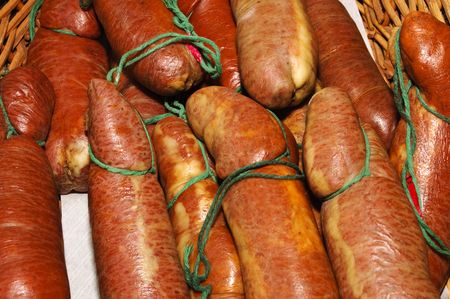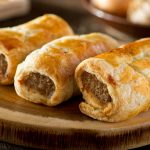
Recently having visited Mallorca (Majorca) I noticed some very curiously shaped sausages hanging in the windows of various butchers, tourist shops and even the airport on the way in at the local deli. Now for me, the typical Spanish sausage is chorizo or morcilla but I was confronted by the sobrassada which I’m not that familiar with.
Further investigation of these rather contorted meats presented an interesting diversion. Firstly, they are from the Balearic Islands which not only includes Mallorca but Minorca, Ibiza and Formentera. Made anywhere else and they would have to be known by another name. As with many meat dishes that are Spanish, it is the noble pig which provides the meat for this delicacy and it is a black pig at that. These black pigs incidentally can be seen quite often rooting about in fields on the plains of all the islands.
Sobrassada is a raw, cured sausage which is made mainly with ground or highly minced pork, salt and spices. Originally it would have been a pale pink meat product but with the arrival of paprika from South America in the late 15th Century, took on the orange, slightly pink colouring that is more commonly seen. It shares some similarities with another sausage such as botifarró because they both made during the festive rites of the Autumn and early Winter season. This period which is when many of the pigs are slaughtered for food is called matança in the Balearics and matanza in Castillian Spanish in Majorca and Eivissa.
Eating pork generally in Spain was resumed following the reconquest of Spain from the 15th Century and was widely adopted with some gusto. It had been banned throughout Spain during Moorish rule because they were of the Islamic faith. Sobrassada probably originated on those islands brought under Catalan control and would include Sicily and Sardinia too because they also produce similar styles of this sausage.
Pork was also the main meat on an island which although generally wealthy in terms of food did not support other meat production. Large cuts of meat from both beef, lamb and pork were reserved for festivals or those who were wealthy enough to afford it. Sobrassada was adopted because it allowed for all parts of the animal apart from the squeal to be used effectively and the skin was always the parts of the intestine.
To prepare sobrassada requires a good quality pork loin and some bacon or pancetta known as xuia which is minced or ground together. This is minced with salt, black pepper and some paprika. All of this mixture is filled into various parts of the pig intestine hence the odd shapes that are possible. If cayenne pepper is added to the mix, then the sausage is described as coent or hot. The whole sausage is hung from poles and cured for a number of weeks. It relies on dehydration during the late Autumn which is characterised by high humidity but just warm enough. The bigger types rely on longer curing times which means the consumption of the product can be staggered throughout the year. The thinnest types are eaten first leaving the larger to be consumed later on. It’s surprising the meat mixture doesn’t rot or become unsafe however it is the case that there are enough hurdles to prevent Clostridium bacterial growth for example.
The different shapes of the sausage are due to different parts of the intestine being used. The fattest and usually largest are known as cular or pultrums. The biggest of all use pork bladders and called bufetes or bisbe (bishop). The small intestine is needed for the small and thin sobrassadas known as llonganissa.
The string used to hang the sausage up by characterises the levels of heat. Red, and red and white string usually signifiy hot or spicy whilst the ‘sweet’ or dolç indicate non-spiciness.
The product is regarded as a breakfast treat and is certainly to be tried especially with bread. Some are quite soft mushy in texture and reminded me of uncooked mince which in effect they are. Its probable that the longer they are left the harder or more coarse they can become.

I absolutely love this for breakfast. It is so unusual to have what is a sausage pate so early in the morning with bread and some garlic. Breath reeks a bit but very Majorcan.